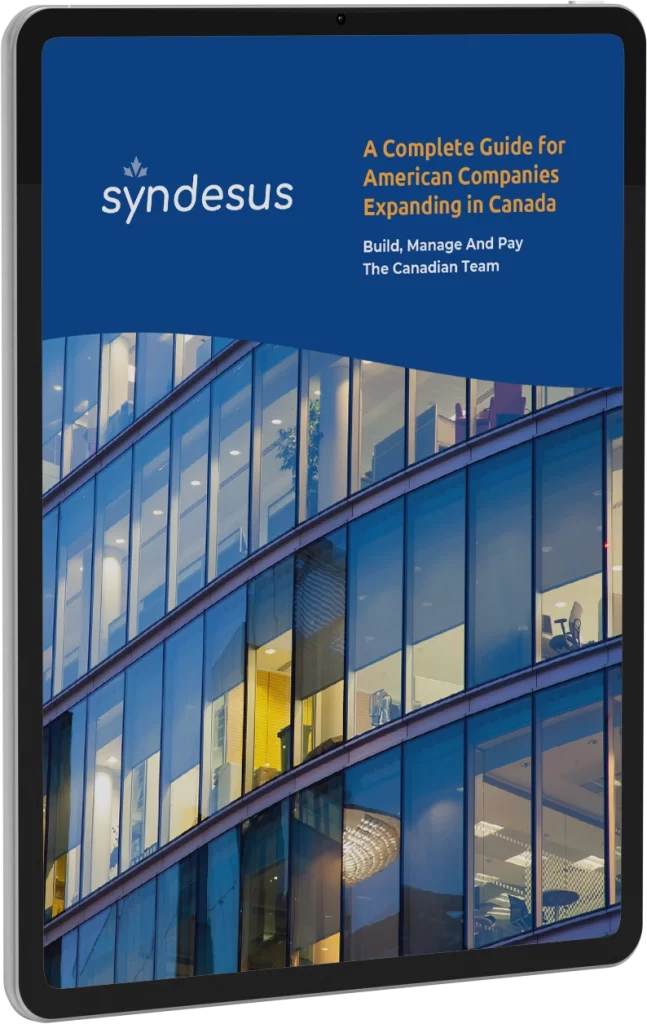The technology sector in Canada has exploded in recent years, as home-grown companies and foreign giants alike hired thousands of highly skilled workers. Yes, the industry has taken a hit with inflation and layoffs, but despite some uncertainty in the tech sector, Canada is still a wonderful country for immigrants to call home and develop their technology careers.
Because of Canada’s broad appeal, plenty of tech workers with good US jobs are considering a move North. But rather than resigning and finding a new Canadian job, it’s possible for tech workers to take their current US jobs with them to Canada.
Generally, there are two ways to do this. First, if an individual works for a tech company with a Canadian office, they can ask to be transferred. And if that’s not possible, the US employer can hire the tech worker remotely in Canada with the help of an employer of record, also known as a PEO.
Let’s take a look at both options.
Transfer to a Canadian branch of your company
There are over one hundred immigration pathways to Canada.
The most popular is the Global Skills Strategy, but there are other, less well-known programs that are similarly helping Canada remain a top destination for new companies and talented individuals. One such program is called the intra-company transfer visa.
The intra-company transfer (ICT) program allows key employees of a company that has a parent, branch, or affiliate company, or is looking to open up a new office in Canada, to be able to move to Canada and get work authorization. This pathway allows tech workers in the US to transition to work in Canada.
Processing time for the intra-company transfer depends on the country of origin, but generally, intra-company transfer applicants qualify for a 2-week processing time under the Global Skills Strategy.
While we’re not a Canadian immigration law firm or consultancy, we wanted to share some of the high-level requirements for the ICT.
Basically, in order to qualify for the ICT program, the prospective transferee needs to check a few boxes:
- First, the applicant must have worked for the company for at least one year on a full-time basis.
- Second, they must have been offered a position with a Canadian branch, affiliate, or subsidiary of the foreign company.
- Third, they must fall into one of these three categories:
- Executives who receive only general supervision or no supervision from other executives, directors, or shareholders.
- Senior managers who supervise other managers or who manage essential functions within the business.
- Workers with specialized knowledge or an advanced level of expertise.
The transferee must provide documentation to prove that they qualify for the intra-company transfer program.
This documentation must also include a thorough description of the applicant’s present position as well as information regarding their executive or managerial capacity in Canada.
And if their application requires them to have “specialized knowledge,” they must demonstrate this knowledge.
One of the main benefits of intra-company transfers for employers is that they do not need to obtain a Labour Market Impact Assessment (LMIA).
An LMIA basically demonstrates that there will be no negative impact on the Canadian labor market by employing this particular individual, but getting an LMIA can be a lengthy, expensive, and stressful process.
Processing time for the intra-company transfer depends on the country of origin, but generally, intra-company transfer applicants qualify for a 2-week processing time under the Global Skills Strategy.
For executives and senior managers, the duration of the intra-company transfer work permit is seven years, and it’s five years for skilled knowledge employees.
When a transferee’s maximum duration has expired, they must work full-time outside of Canada in order to reapply for the program.
However, they may also become eligible for permanent residence, which would allow them to stay in Canada permanently.
If the US-based company in question doesn’t have an office in Canada, they can still easily move their employee to Canada and hire them through an employer or record, or a Canadian PEO.
No Canadian office – no problem. A PEO makes it easy for you to legally employ workers remotely from Canada.
Global Talent Stream (GTS) — part of Canada’s Global Skills Strategy — empowers Canadian employers to speed up the process of hiring skilled foreign workers to fill specialized jobs.
You can get permission for employees to work in Canada through GTS in less than two weeks, which makes it, without question, one of Canada’s quickest immigration routes.
There are two main reasons that the Global Talent Stream is a popular immigration pathway:
- It has expedited processing means that workers can have a work permit in approximately 10 days,
- The program is an excellent pathway to permanent immigration to Canada. To be eligible for Canadian permanent residency, you just need one year of work experience in Canada.
Using GTS to hire top talent may be easy for companies with an office in Canada, but for the majority of US companies that don’t have a Canadian presence.
The good news is that these businesses may still benefit from Canada’s GTS program. A PEO is what you’ll use to do it.
A Canada-based PEO — like Syndesus — can be the legal employer of this American tech employee.
With a little assistance from a PEO, you can keep your US job and work remotely in Canada. A Canadian Professional Employer Organization like Syndesus, or PEO, allows a US firm to hire employees in Canada without having an office there.
It’s really quite simple.
An American technology worker at a US-based company who wishes to migrate to Canada and keep their present employment can do it without the US company having to open up an office in Canada.
A Canada-based PEO — like Syndesus — can be the legal employer of this American tech employee. The PEO would take the employee on their Canadian payroll and handle all technical aspects of employment, such as paying wages and offering benefits.
But here’s where things get interesting — the original US tech company would still be in 100% control of the job, would be the one paying the salary, can offer stock options, and more.
It’s as if the US firm had a branch in Canada.
The US-based company chooses the workers through a traditional interview process, and they manage these workers like any other employee. You may keep your American employment while still enjoying the benefits of living in Canada.
If your US employer has never hired anyone remotely in another country, this isn’t a typical conversation to have with them. This means you need to make a case for it, and a strong one at that. Fortunately, we’ve written a playbook with five reasons that you can present to your employer to make the case that they should let you move to Canada and work remotely.
Whether you want to take your American job to Canada or start fresh with a new tech job, you have plenty of pathways for Canadian immigration.
Syndesus can help move your US job to Canada
Despite the recent slowdown of growth in the tech sector, Canada is still the ideal place to create a home and advance your career. Talented tech workers continue to move north to Canada from the US. If you’re interested in following them to Canada, Syndesus can help.
Syndesus helps individuals relocate to Canada and continue to work remotely for their US employer. Syndesus also supports small and mid-size US companies that don’t have an office in Canada to expand their Canadian workforce.
If you’re interested in taking your US job with you to Canada, reach out to us to learn more!

